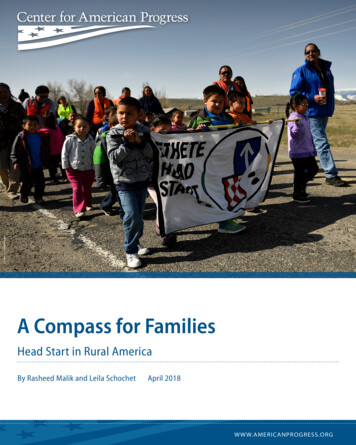
Transcription
JOE AMON/GETTY IMAGESA Compass for FamiliesHead Start in Rural AmericaBy Rasheed Malik and Leila SchochetApril 2018W W W.AMERICANPROGRESS.ORG
A Compass for FamiliesHead Start in Rural AmericaBy Rasheed Malik and Leila SchochetApril 2018
Contents1 Introduction and summary6 Background9 Key findings17 Lessons from the ground21 Conclusion22 About the authors23 Appendix: Methodology, limitations,and detailed findings31 Endnotes
Introduction and summary“Families talk about the Head Start program with joy, and they love being in theprogram, so in rural communities we have to embrace that role as the compassfor families. Not to intervene, but to partner with them in raising their families,to help show them the way in the face of toxic stress.”–Missouri Head Start program director1Nome, Alaska, situated on Alaska’s west coast near the Arctic Circle, boasts postcard-worthy views of the state’s wilderness and is the finish line for the IditarodTrail Sled Dog Race.2 It is also home to nearly 4,000 residents and serves as thehub for nearby Kawerak Head Start, a grantee that operates 11 centers across theSeward Peninsula and Saint Lawrence Island.3 Their Head Start programs are theonly early education options in the region, serving about 240 Alaska Native children from remote villages and towns.4Serving young children and families in remote areas requires creativity, as it comeswith serious challenges.5 Supplies, food, and sometimes even staff must be flownout to these isolated communities weekly, which drives up costs. Accordingly,remote rural Alaskans are accustomed to paying more for necessities—even morethan other Alaskans pay. Fuel must be shipped in on barges once each year; a gallon of milk can cost as much as 10 dollars; and village water systems can sometimes freeze up in the winter, forcing an entire town to use bottled water.6Nevertheless, Kawerak Head Start has been able to make it work. Most of theregion’s towns lack health service providers, so the program flies in a dentist,audiologist, and vision screener twice a year. But what may be typical expenses forthe average Head Start program can be major expenses for Kawerak Head Start.Regular teacher trainings require flights to Anchorage, Alaska, which can cost 800in addition to hotel and per diem costs. The harsh weather also takes its toll onprogram facilities and leaves some of Kawerak’s buildings in dire need of repair.71Center for American Progress A Compass for Families
While Kawerak Head Start is an extreme example, its budgetary challenges andcommunity needs resemble those of many other rural Head Start programs. It alsoembodies the mission of Head Start: to provide comprehensive services to youngchildren and their parents no matter the challenges that might entail. Across thecountry, Head Start provides early education and medical, dental, and familyservices in areas where few other providers exist, bringing necessary resources tofamilies where they live and work.FIGURE 1Head Start reaches far and wideHead Start locations in and around Nome, AlaskaRussiaKotzebueNomeSource: Authors' analysis of 2017 Head Start location data. See U.S. Department of Health and Human Services, "Head Start Center Locator," available at https://eclkc.ohs.acf.hhs.gov/center-locator(last accessed March 2018).2Center for American Progress A Compass for Families
The very parts of country life that many rural residents cherish most—theundisturbed wilderness, the vast open spaces, and the independent lifestyle—can present enormous challenges when it comes to early education and servicedelivery. Low population density means that local governments and nonprofitsface funding challenges and service delivery may become very costly when greatdistances are involved. As a result, resources and public services in rural areastend to be scarce.8At the same time, child poverty has been persistently high in rural areas.9 Dueto rural communities’ physical isolation, it is usually more difficult to deliverservices such as education, nutrition, and health care to families struggling tomake ends meet.For more than 50 years, Head Start has delivered a broad set of services to thesestruggling communities. Head Start helps vulnerable children by providing acomprehensive array of educational, nutritional, dental, medical, and mental healthservices. The programs also foster parental engagement, offer parent trainings andworkshops, and connect families with a variety of social services that counter theinnumerable daily challenges of living without consistent access to basic necessities.In recent years, the benefits of Head Start have become even more clearly defined.Children who participate in Head Start have improved social-emotional and cognitive development; show higher levels of school readiness; and are more likely tograduate from high school and attend college.10 Head Start has even demonstratedintergenerational benefits, with reductions in teen parenthood and criminalbehavior and increases in high school graduation and college enrollment rates forthe children of Head Start alumni.11Despite sometimes facing significant challenges, Head Start provides evidencebased, locally administered services to hundreds of thousands of rural childreneach year at one of the most critical stages of their development. This reportassesses the scale and scope of Head Start in rural communities by analyzingProgram Information Reports (PIR) from several thousand rural Head Startlocations across the United States using geographic analysis tools to separaterural providers from their metropolitan counterparts as well as collecting insightsvia interviews with 20 rural Head Start administrators. For the purposes of thisreport, the authors use the general term “Head Start” to refer to the Early HeadStart, Head Start, Migrant and Seasonal Head Start, and American Indian andAlaska Native Head Start programs. This report excludes Head Start locations inPuerto Rico and U.S. territories. (see Appendix for full methodological details)3Center for American Progress A Compass for Families
This comprehensive assessment finds that without Head Start, many ruralcounties would be left without any child care centers.12 Head Start currentlyoperates programs in nearly every rural county in the United States and is oftenthe sole service provider for families in remote communities suffering frompersistent, deep poverty.13Key findings from this report include: Head Start has centers in 86 percent of America’s 1,760 rural counties. (seeFigure 2) In the 2015-2016 program year, rural Head Start programs enrolled more than175,000 children, employed nearly 50,000 staff, and delivered family services tomore than 110,000 families. Within a 10-state sample, this study finds that 1 out of every 3 rural child carecenters is a Head Start program. Across those 10 states, CAP identifies 48 counties that would have no child carecenters if not for Head Start. Despite higher poverty rates, fewer resources, and unique challenges, ruralHead Start programs provide children with an evidence-based early educationand connect families with critical services at rates similar to those of Head Startprograms in metropolitan areas.Rural Head Start programs help fill a crucial role in delivering educational,health, and parent education services to families with few other options forassistance. Furthermore, these programs are often the only high-quality earlyeducation programs in rural communities, which helps parents work the hoursnecessary to get back on their feet.4Center for American Progress A Compass for Families
FIGURE 2Head Start serves nearly every rural county in AmericaRural counties with and without Head Start locationsMetropolitan countiesRural counties with Head StartRural counties without Head StartNote: For a definition of rural counties, see Methodology.Source: Authors' analysis of 2017 Head Start location data. See U.S. Department of Health and Human Services, "Head Start Center Locator," available at https://eclkc.ohs.acf.hhs.gov/center-locator(last accessed March 2018).5Center for American Progress A Compass for Families
BackgroundThe United States is the wealthiest nation on earth, yet it ranks near the bottomof the world’s advanced economies in terms of child poverty—above only a few,significantly poorer countries.14 According to recent estimates, more than 1 in 5children in the United States lived in households below the federal poverty line.15American children currently comprise 23 percent of the overall population butrepresent 33 percent of those living in poverty.16The nation’s youngest children—those under age 6—are more likely to experience poverty than any other age group.17 American families with young childrenhave significantly lower incomes than similar households without children, orthose in which children have reached school age.18 In the absence of policiesthat help cover the costs of parental leave, child care, or the everyday expensesthat children bring, young parents are often strained by low wages, irregularhours, and household debt.19These hardships are particularly acute for rural families, resulting in child povertybeing significantly worse in rural areas than in metropolitan areas. By the definition of rural used in this report (see text box below), more than 29 percent ofrural children under age 5 live in poverty, compared with 23 percent of youngchildren in metropolitan counties.20 (see Figure 3) Children living in rural areasare also more likely to experience deep poverty, which for a family of four meansliving on an income of less than 1,000 per month.21 This study finds that youngchildren in rural counties are 37 percent more likely to live in deep poverty thantheir metropolitan peers.226Center for American Progress A Compass for Families
FIGURE 3Child poverty is higher in rural countiesPoverty rates for young children, by rural statusPoverty rateMetropolitan countiesRural countiesDeep poverty rate ( 50% FPL)23.0%9.2%29.3%12.6%Note: The poverty rate is calculated for children under the age of 5, while the deep poverty rate was calculated using the populationof children under the age of 6, due to data availability.Sources: Authors' analysis and U.S. Department of Agriculture, Economic Research Service, “Child Poverty,” available pulation/rural-poverty-well-being/child-poverty/ (last accessed March 2018).Head Start plays a critical role in mitigating the effects of poverty for children andfamilies in rural areas. The experience of poverty can cause toxic stress, meaningthat both children and their families need added supports.23 In low-density ruralareas, however, these resources may be hard to find or many miles away. HeadStart has been designed to be geographically dispersed and to connect familieswith a variety of wraparound services in addition to high-quality early education.24Although Head Start plays an important role in helping rural families, there is adearth of research on how Head Start programs in rural areas serve families whencompared with overall Head Start service rates. The limited research on ruralearly education shows that children in rural America are less likely to attend earlychildhood education programs. One study found that 34 percent of children inthe most rural census tracts entered kindergarten without any prior preschoolparticipation, compared with only 24 percent in nonrural areas.28 Another majorstudy noted that “research on Head Start and related educational programs forlow-income children has historically focused almost exclusively on low-income,urban environments.”29This report explores the critical role that Head Start plays in rural areas usingfindings from analyses of data from the 2015-16 Head Start Program InformationReport and interviews with rural Head Start administrators. (see Appendix)7Center for American Progress A Compass for Families
What does “rural” mean, anyway?Research on rural communities can be complicated since there are several competingdefinitions of “rural.” According to the U.S. Census Bureau, any small town with morethan 2,500 residents is coded as an urban cluster, even though many of these smalltown residents would consider themselves rural dwellers. For this report, therefore, theauthors use the rural-urban continuum codes developed by the U.S. Department ofAgriculture’s Economic Research Service (USDA-ERS). These codes place each American county into 1 of 9 categories, with 1 being the most urban and 9 being the mostrural.25 This report defines any county between 5 and 9 on this spectrum as rural, whichproduces 1,790 rural counties.To aid in the study of rural economic characteristics, USDA-ERS developed county-leveldesignations to track county conditions such as population loss, low employment, andpersistent child poverty. Looking closer at the counties designated as persistent childpoverty counties—in which the child poverty rate has been greater than 20 percentsince 1980—this study finds that 75 percent are rural.26 Head Start serves 95 percent ofthese USDA-designated persistent child poverty counties, funding annual enrollment ofnearly 75,000 children across more than 4,000 classrooms.278Center for American Progress A Compass for Families
Key findingsThis section outlines findings from an original analysis of Head Start in ruralareas. The section first presents data on the number of children enrolled and staffemployed in rural Head Start programs. It then highlights the important role thatHead Start fills in the supply of center-based child care in rural child care deserts.Finally, it presents findings on the scale and scope of comprehensive health andfamily services delivered to rural families through Head Start and compares service delivery rates among rural and metropolitan programs.Enrollment and staffingIn the 2015-2016 program year there were 177,249 federally funded Head Start slotsacross 10,165 classrooms in rural counties. This accounts for about one-fifth of totalHead Start enrollment in the United States. (see Table A2 in the Appendix for HeadStart enrollment by state and rural status) Compared with metropolitan areas, inrural areas, Head Start serves a larger share of the population of children under age 6.TABLE 1Head Start serves a larger share of the child populationin rural countiesHead Start enrollment in rural and metropolitan countiesFunded HeadStart enrollmentTotal populationunder age 6Percent of totalpopulation 1643.3%Source: Authors’ analysis; see Methodology.9Center for American Progress A Compass for Families
Head Start employs nearly 50,000 staff in rural areas. Well over a quarter—29percent—of staff in rural Head Start classrooms are current or former parents. Thisis significantly greater than the just one-fifth—20 percent—of staff in metropolitanarea classrooms.Head Start in rural child care deserts“If not for Head Start, there would be a lot of families that wouldn’t be able to gettraining, go to school, or look for jobs because there’s nowhere for their kids to stay.”–Mississippi Head Start advocate30In a prior 22-state investigation of licensed child care supply, CAP found thatsmall towns and rural areas with below-average median family incomes faced thedeepest shortage of child care. These areas, referred to in the research as childcare deserts, are home to approximately 3 in 5 rural Americans.31 These findingsprompted the question of whether Head Start is potentially working to fill a gap inavailable quality child care for these undersupplied communities.Many rural families living below the federal poverty line are working families.Fifty-five percent of rural Head Start children have at least one employed parent.32 (see Table A4) Interviews with rural Head Start administrators repeatedlyconfirmed that while most Head Start parents are working, many are workinglow-wage jobs, often with nontraditional or inconsistent hours.33 As one Kansasdirector explained, “Quality child care is difficult for our families to find. Mostfamilies work; they work low-paying jobs, often not full time. [This is a] majorchallenge for families.”34These findings align with much of the research literature, which finds that ruralfamilies have unique child care needs.35 Often there are very few quality child careoptions within a reasonable distance, and parents resort to using unlicensed carethat is not regularly inspected.36 While Head Start provides localized services thatmatch community needs, the program boasts evidence-based quality standardsthat must be implemented regardless of location.37 According to one MissouriHead Start director, “there are two counties [in the region] where there is nolicensed child care. Even when they are operating legally, the standards are not upto the Head Start quality.”3810Center for American Progress A Compass for Families
For families living paycheck to paycheck, any quality child care options wouldlikely be unaffordable, even with state child care subsidies, which usually onlycover a portion of the child care bill.39 Finding qualified teachers and staff alsoposes a significant challenge for rural programs and could contribute to the dearthof child care in rural areas.Head StartCAP’s analysis of a 10-state sample reveals that Head Start programs representapproximately one-third of the center-based child care programs in these states’rural counties. In terms of child care slots, rural Head Start programs in these10 states represent 22 percent of the overall child care capacity, even whenincluding home-based care. To conduct this portion of the analysis, this studyexamined 739 rural counties across 10 states, comprising 40 percent of the ruralpopulation of the United States. These 10 states have the highest number ofrural counties among the states with publicly available data on child care locations. (see Methodology)one-third of theSince Head Start mostly serves 3- and 4-year-olds, the authors compared HeadStart supply to center-based child care supply. This is because a majority of parentsprefer center-based care for their 3- and 4-year-olds.40 Among the 739 rural counties studied, there were nearly 1,900 Head Start centers, while there were around4,000 other child care centers.The study also finds that, when excluding Head Start, one-quarter of the ruralcounties in the 10-state sample have either zero or only one child care center. Theseunderserved rural counties would have almost no child care centers available tofamilies were it not for Head Start. In fact, across these undersupplied rural counties, Head Start accounts for more than 70 percent of the center-based child caresupply—252 Head Start providers versus 103 non-Head Start child care centers.Head Start fills an especially large gap in very remote rural counties, sometimesreferred to as “frontier counties.”41 Using USDA-ERS rural-urban codes 8 and 9to identify frontier counties, the authors analyzed the supply of licensed centerbased care versus Head Start locations. Among the frontier counties contained inthis 10-state sample, Head Start programs represent nearly half of the center-basedchild care supply.42 (see Figure 4)11Center for American Progress A Compass for Familiesprograms representapproximatelycenter-based childcare programsin these states’rural counties.
FIGURE 4Head Start fills a child care gap in rural and frontier countiesShare of the child care centers that are Head Start grantees, by type of countyHead Start45%Frontier counties32%Rural countiesMetropolitan countiesNon-Head Start13%55%68%87%Note: Metropolitan counties have a rural-urban continuum code of 1 through 4; rural counties are coded as 5, 6, or 7; frontier countiesare coded as an 8 or 9.Source: Authors' analysis; see Methodology.This analysis identifies 48 counties in the sample in which Head Start was the onlycenter-based child care provider.43 These counties, which are spread across 9 of the10 states in the sample, can be found in the Appendix. It is not hyperbole to saythat without Head Start, there would be no child care centers to educate and carefor young children in these counties.All Head Start providers must meet high-quality federal standards that encompasschildren’s cognitive, socio-emotional, and physical development, which meansthat in areas with few other child care options, Head Start is often the highestquality preschool in rural areas.44 This assessment is backed up by the fact that theHead Start Impact Study report—the gold-standard evaluation of the program—found that Head Start’s largest and longest-lasting positive effects were concentrated among rural providers. The 2010 study found that 3-year-olds who attendHead Start programs in rural areas experienced significant and longer-lasting cognitive benefits and greater socio-emotional development than their urban peers.45It is possible that Head Start had this outsized impact in rural areas due to shortages of high-quality alternatives to rural Head Start, whereas metropolitan areasfeature a greater number of high-quality alternatives. The results of this analysisalign with that hypothesis.12Center for American Progress A Compass for Families
Comprehensive services“One of the things that is important about Head Start is the family approach.If there are issues that are keeping that family from reaching their full potential,Head Start connects people with the local and sometimes state resources toimprove their situation.”–Mississippi Head Start advocate46Head Start is a two-generation program, meaning that it targets services to bothlow-income children and their parents to promote family wellbeing. Particularlyfor families in underserved rural areas, Head Start may be the first point of contactwith trained service providers who can make referrals to community resources.In the 2015-2016 program year, 68 percent of rural Head Start families receivedsome type of family service through Head Start. (see Table 2) This includes services such as parenting education, job training, and substance abuse prevention.TABLE 2Most Head Start families are connected with services beyond early learningNumber and share of Head Start families that received family services through Head Start, by type of countyNumber of ruralHead Start familiesreceiving servicesShare of ruralHead Start familiesreceiving servicesNumber ofmetropolitanHead Start familiesreceiving servicesShare of metropolitanHead Start familiesreceiving services112,74068%503,02770%Parenting education85,42852%353,04549%Health education76,41446%299,87242%Emergency/crisis intervention28,72917%125,68218%Adult education16,43710%82,50212%Mental health set building services13,9498%48,2917%Child abuse and neglect services13,5708%56,3688%Job training11,1337%53,0177%Substance abuse prevention7,6505%18,5423%ESL training3,7892%37,1765%Substance abuse treatment2,2831%5,4221%Types of family servicesTotal families that received some typeof family service through Head StartNote: Categories do not sum to the total shown, since many families receive more than one type of service.Source: Authors’ analysis; see Methodology.13Center for American Progress A Compass for Families
Health services“In a lot of cases, Head Start is the only program in town. Often a pediatricianwill say, you need to take your kids to Head Start or Early Head Start so thatthey can get help for these developmental delays.”–Mississippi Head Start advocate47In many rural areas, Head Start is one of the only health care providers andconnects children to services they may not otherwise receive. The U.S. HealthResource and Services Administration designates Health Professional ShortageAreas (HPSAs) based on the availability of primary care, dental, and mentalhealth providers in the nearby area.48 CAP’s analysis finds that the overwhelmingmajority of HPSAs are located in rural counties.49 Not surprisingly, children inrural areas receive fewer health care services than children in metropolitan areas.According to the 2011-2012 National Survey of Children’s Health, children inrural areas were less likely to have had a preventive health or dental care visit in thepast 12 months than were children in metropolitan areas.50Head Start is present in about 80 percent of rural HPSA counties and providesthousands of rural children with the necessary health and developmental screeningservices they need to thrive.51 Despite deep shortages in dental and mental healthprofessionals in rural areas, Head Start programs connect families with dental andmental health services at rates comparable to areas with greater service coverage.Rural children typically enter Head Start having had lower rates of access toimportant services than children in metropolitan areas. (see Figure 5) The analysisshows, for example, that 90 percent of metropolitan Head Start children are up-todate on their immunizations at the beginning of the school year, compared withjust 83 percent of rural Head Start children. These gaps persist, as children in ruralHead Start programs remain behind their metropolitan peers in rates of servicereceipt through the end of the year.14Center for American Progress A Compass for Families
However, rural Head Start programs are bringing children up-to-date on screenings and immunizations at similar rates to programs in metropolitan areas. Despitethe fact that rural children are starting behind, Head Start makes similar progressin connecting children with services. End-of-year rates of Early and PeriodicScreening, Diagnostic, and Training, immunizations, and dental service receiptare lower for children in rural areas, yet they still increased by roughly the sameamount as rates for metropolitan children over the course of the 2015-2016school year. Even Head Start programs in areas designated as HPSAs seem tosuccessfully overcome challenges to provide health services to young children:Interestingly, Head Start providers in rural primary care HPSAs vaccinate a higherpercentage of their children than rural non-HPSAs—12 percent versus 8 percent.This may be because rural children living in HPSAs often miss their vaccinationsdue to primary care shortages.FIGURE 5Rural children entering Head Start are often behindon health screeningsHead Start service receipt rates, at beginning and end of yearRuralMetro57%Children up to date onpreventative and primaryhealth care (EPSDT)*87%67%92%83%Children up to dateon all age-appropriateimmunizations **88%90%79%Children with continuousdental care ***90%87%40%60%96%80%98%100%*Number of all children who are up to date on a schedule of age-appropriate preventive and primary health care according to therelevant state's EPSDT schedule for well-child care**Number of children who have been determined by a health care professional to be up to date on all immunizations appropriate fortheir age***Number of children with continuous, accessible dental care provided by a dentistSource: Authors’ analysis of U.S. Department of Health and Human Services, "2015-2016 Head Start Program Information Report,"available at ing/article/program-information-report-pir (last accessed March 2018).15Center for American Progress A Compass for Families
Head Start and the rural drug overdose epidemic“There is lots of substance abuse across the service area, lots of family trauma and mental health—these things are exacerbated in a rural community because there are no resources to help with those.Families have so many stressors in their lives but are unable to get connected with the services toalleviate stressors. There’s nowhere to go for help.”–Montana Head Start director52In October 2017, the Centers for Disease Control andConsider some snapshots of the rural drug epidemicPrevention (CDC) issued a press release announcingfrom the Head Start Program Information Report:that drug overdose deaths have been steadily risingin rural areas and have now surpassed the overdose53death rates in metropolitan areas. This has largely Head Start enrolls more than 10,000 children inthese 63 rural drug epidemic counties.been driven by massive increases in illicit prescription and opioid drug use. In the past 15 years, the In rural counties, Head Start families both reportedopioid death rate has quadrupled among younga greater need for substance abuse prevention andadults in rural areas.54treatment services and received these services at ahigher rate than families in metropolitan counties.Head Start programs are on the front line of theopioid epidemic and are uniquely positioned to take In rural drug epidemic counties, 16 percent of Heada full family approach to addressing the deep andStart families received child abuse and neglectdamaging effects of drug addiction. Programs workservices, compared with only 8 percent of families into prevent harm and promote healthy child devel-all other rural counties.opment for Head Start children, while connectingparents and families with the services they need to In rural drug epidemic counties, Head Start familiesaddress drug misuse and cope with the accompany-receive domestic violence services at more thaning trauma. Head Start offers relevant services totwice the rate of other rural counties—6 percentfamilies, including substance abuse prevention andversus 2.5 percent.treatment services, child abuse and neglect services,parent coaching, domestic violence services, andmore. (see Table 2) In rural drug epidemic counties, 5 percent of children in Head Start lives with their grandparent(s),compared with 3 percent of children in other ruralIn the course of this research, the authors analyzedcounties and only 2 percent of children in metro-CDC drug overdose death rates from 2011-2015,politan counties.the most recent year
In recent years, the benefits of Head Start have become even more clearly defined. Children who participate in Head Start have improved social-emotional and cog-nitive development; show higher levels of school readiness; and are more likely to graduate from high school and attend college.10 Head Start has even demonstrated











